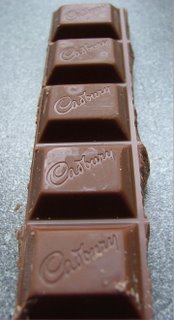
Cadbury are running a fascinating commercial for their Dairy Milk chocolate here at the moment. It begins with a retro scene of a young teen boy on a coach, passing two pieces of the chocolate through the gap in the seats, coyly offering it to the girl sat in front of him; then traces their relationship – first date, wedding, family portrait with young son; and ends with the family on a coach today, mum and dad knowingly looking on as their son, sat in front of them, passes two pieces of chocolate through the gap in the seats, coyly offering it to the girl sat in front of him…
Advertising goes way beyond a simple pitch in the hope we will buy. No-one decides to go out and buy a car while watching a car advert; the aim is to create a framework in the mind so that, when we do decide to buy a new car, we have a particular make and model in mind. Though the cost is in no way comparable, the same is true for groceries, and broadly true even for a chocolate bar. Cadbury works hard to make sure that when we do think of chocolate, we think of their chocolate.
I’d hazard a guess that this particular campaign is targeted at parents, of children not-yet in their teens, who aspire to still having a close relationship with their children by the time they are teenagers – and if they have any guilt over the lack of “quality time” they spend with their kids, so much the better. (It is unlikely – and not the aim – that teenagers themselves will actually take to using chocolate as a means of brokering their relationships [that is what txts are for!] and at some point Cadbury may use a very different campaign pitched at them…) The commercial doesn’t so much play on the shared social activity of eating chocolate together (a simple pitch) as it makes the claim that Cadbury, as a specific manufacturer, fulfils a social-glue role between the generations of a family (a more complex pitch; and a more subtle one, including disarming the audience with blatant improbability and faux naïveté). Established companies such as Kellogg (breakfast cereal – celebrating their centenary this year) and Warburton (bread) make the same claim in their advertising. They seek to be foremost in our mind when choosing between brands by presenting a picture of the family, in which family is defined as those you eat this product with; and held-together by our shared experiences of eating.
The process is a circular one: the food itself perpetuates its own central place in the life of the family, nourishing the body by first nourishing the imagination, and re-nourishing the imagination each time the body is nourished. The process is also (or, at least, claims to be) a cyclical one: the family is brought together by a food (food as rite-of-initiation); held-together by that food (food as rite-of-re-membering, or, bringing back together); and releases the next generation through that food (food as rite-of-passage).
The sacrament of Holy Communion works in a very similar way, to construct a stable/dynamic family of those who share the bread and the wine. It is the patte[r]n on which the Cadbury/Kellogg/Warburton model is based: it is, one might say, the Original and the Best…
Cadbury advertising Communion socio-gastronomics

you are getting very deep recently!
ReplyDeletesad to see I am not yet in your link list..........
thought I'd give you a chance to post something first! anyway, I've added the link now...
ReplyDeleteby the way, please change our email address in your contacts to andrewandjo[at]dowsetts[dot]net